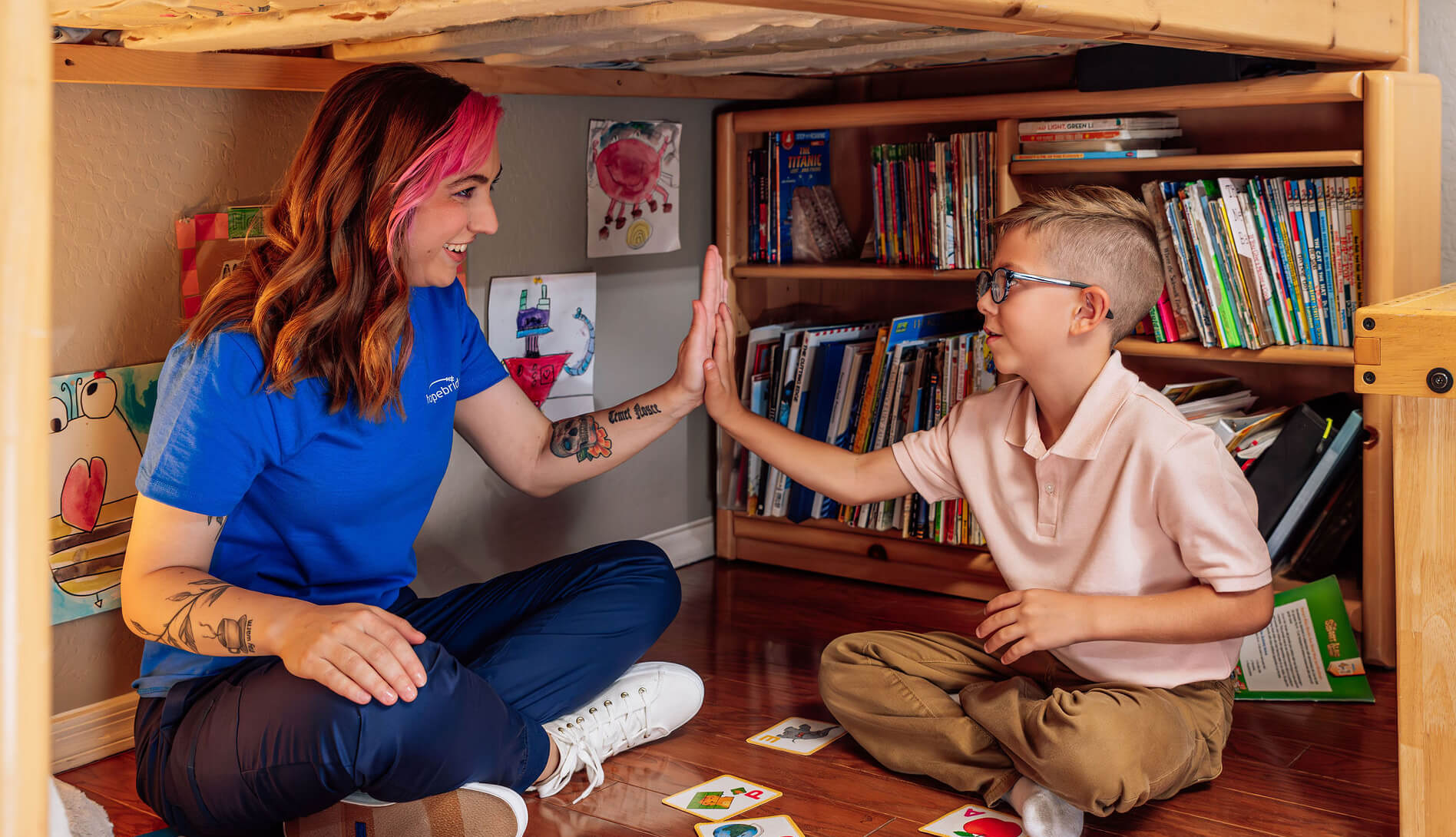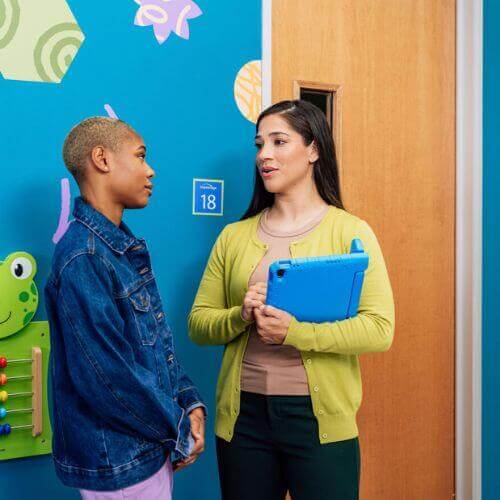Tips for Speech Pathologists and Behavior Analysts to Best Support Self-Advocacy
September 22, 2023
September 22, 2023

“I’m hungry.” “I don’t like it.” “Can I have a hug?” “I want that.” “I need a break.” “No.”
To many adults, these phrases can seem simple. We may say them in a range of settings when we’ve had enough or want more of something. We may not think much of them at the time, but each of these sets of words is powerful. They have meaning, no matter how they are communicated. And they do not come easily for everyone.
That is why helping children find their voice is a big focus for many clinicians who practice pediatric therapies like speech-language therapy and applied behavior analysis (ABA)
Nearly every part of what we do at Hopebridge touches self-advocacy skills in some way. Our clinicians spend one-on-one time with our children to learn their strengths, find out what they are already doing and what they can focus on growing and shaping into a more efficient and consistent way to communicate, which in turn, leads to stronger self-advocates.
“Kids need exposure to language and our SLPs provide it in a naturalistic, play-based way. We meet them where they are. We give them access to different modalities. We accept everything when they try, but we’re modeling gestures, signing and verbally narrating along the way,” said Ashley Marshall, the speech pathology clinical specialist at Hopebridge. “Yes, we cover the full scope of everything from social communication to motor speech disorders, but our overall goal is to give kids a voice. Everything else will fall into play within that.”

Though our ABA and outpatient services are centered around the child, our efforts would be much less successful without our family guidance sessions and caregiver discussions. For some caregivers, this includes training around high-tech, speech-generating devices. For others who care for kids with a speech sound disorder, our sessions cover what to expect and how to support children who make different patterns of sounds when speaking. Helping caregivers better understand their children in turn supports their child’s wants and needs.
“We spend so much time with the kids, but working with their communication partners is just as important. Any type of communication is only as good as the understanding of the person you are communicating with,” said Ashley.
“When we think of person-centered planning and programming, it is with assent in mind. This is different from many historical practices, but to me, gone are the days where parental consent is sufficient to be able to do something with the individual. We must be intentional about requiring and reassessing for assent from the child on an ongoing basis,” said said Hopebridge Chief Science Officer Adam Hahs, PhD, BCBA-D.
Broadly, the philosophical stance of Hopebridge’s clinical leadership team around assent is shifting to become more person-centered, and with that will come trainings and orientations laden with assent-based practices. To dive deeper into both the vocal and non-verbal indicators of assent being removed, Adam also encourages all clinicians reference the article, “Assent in applied behaviour analysis and positive behaviour support: ethical considerations and practical recommendations.”**
There’s a misconception around ABA and skill-based treatment (SBT) that children are never faced with tolerance, or that it is only about letting them get what they want. Rather, we are being led by their interests. The practice is strategic.
“It is about exploring the environment with our kids; not doing things to them. We are observant of the things they gravitate towards so we can later use it in our work with them. We go to the playground or get on the floor with them as opposed to keeping them in a chair for hours running a discreet trial. That’s agility in a clinician’s ability to modify the environment to be fun, but also one that facilitates learning,” said Adam.
The idea is to initially and intentionally honor “no.” Then, once clinicians find an environment that is enjoyable and comforting to our kids, programmatically they can integrate tolerance through delays to the ultimate “no” by playing with time and reinforcement. We accept no, and then we change it up.
Building off of these concepts, Adam, Ashley and Hopebridge VP of Outpatient Services Alissa Hayes shared five other tips for clinicians who want to instill self-advocacy skills during therapy:
“Self-advocacy doesn’t look one way. How it presents outwardly doesn’t have to be boxed in. I encourage practitioners to think flexibly about what self-advocacy can look like,” said Adam.
Independence and self-advocacy for our children starts at the beginning with the respect we give them and their families. Within the initial evaluation, Adam recommends clinicians change the usual approach. Open with prompts like, “Tell me something beautiful about your child,” or “Tell me something that makes you laugh about them.”

Starting with typical questions like “What are you most worried about?” or even “What kind of skills do you want your kid to learn?” can come across as cold and assume there are massive deficits.
Adam also suggests having the child present for these conversations unless there is a propensity for maladaptive behavior while these questions are discussed. It offers more dignity to have the individual about whom you’re speaking present for the conversation. Involve the child and ask them questions, even if they cannot answer them.
“The world is hard enough. Create a context where caregivers can share the bright side and they will open up much faster than they would with the general tact and bedside manner that has been historically worn by clinicians at large,” said Adam. “I’m advocating for our clinicians to lead with the things that get the family excited about their relationship with their kid. We want to get real buy-in from families and start with what makes them glow.”
At Hopebridge, we look at kids comprehensively and we support them in the same way. Our medical speech pathologists have the opportunity to practice to their full scope across a range of diagnosis groups, covering everything from motor speech disorders and sensory integration challenges to AAC implementation and swallowing. Our board certified behavior analysts (BCBA) work with the underserved pediatric autism population, with access to support and training opportunities in progressive, compassionate care at every level. If this sounds like you and you want to join our mission, check out the open roles in our Hopebridge therapy centers around the country.
**Cassi A. Breaux & Kristin Smith (2023) Assent in applied behaviour analysis and positive behaviour support: ethical considerations and practical recommendations, International Journal of Developmental Disabilities, 69:1,111-121, DOI: 10.1080/20473869.2022.2144969
*Informed consent was obtained from the participants in this article. This information should not be captured and reused without express permission from Hopebridge, LLC. Testimonials are solicited as part of an open casting call process for testimonials from former client caregivers. Hopebridge does not permit clinical employees to solicit or use testimonials about therapeutic services received from current clients (Ethics Code for Behavior Analysts 5.07-5.08; BACB, 2020). Hopebridge does not provide any incentives, compensation, or renumeration for testimonials provided by a former client or client caregiver.